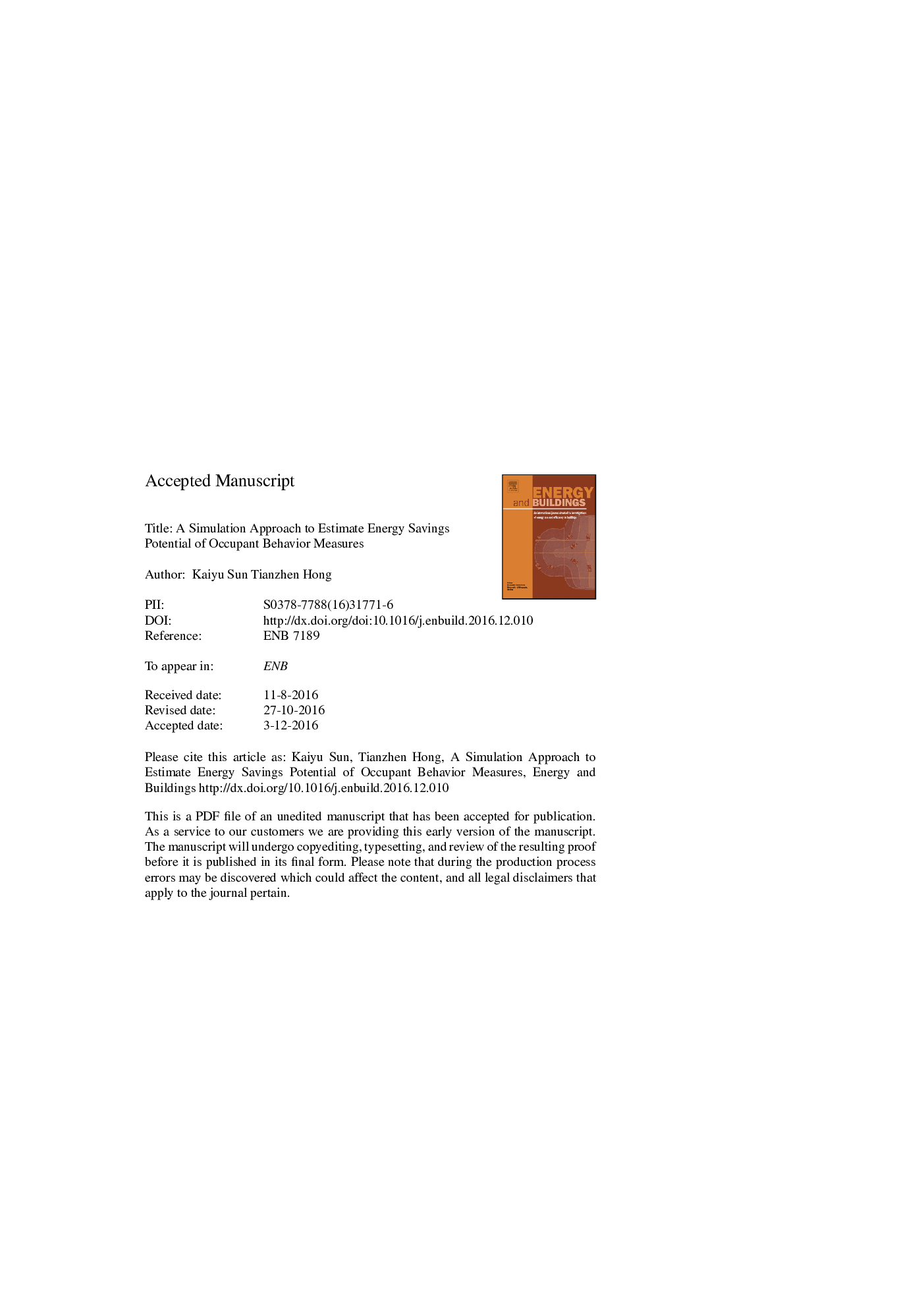| کد مقاله | کد نشریه | سال انتشار | مقاله انگلیسی | نسخه تمام متن |
|---|---|---|---|---|
| 4914228 | 1428954 | 2017 | 45 صفحه PDF | دانلود رایگان |
عنوان انگلیسی مقاله ISI
A simulation approach to estimate energy savings potential of occupant behavior measures
ترجمه فارسی عنوان
یک رویکرد شبیه سازی برای تخمین پتانسیل صرفه جویی در انرژی اقدامات مسافرین
دانلود مقاله + سفارش ترجمه
دانلود مقاله ISI انگلیسی
رایگان برای ایرانیان
کلمات کلیدی
ترجمه چکیده
رفتار شغلی در ساختمان ها عامل مهمی در تأثیر مصرف انرژی در ساختمان ها است. راه حل های کم هزینه برای رفتارهای رفتاری، صرفه جویی قابل توجه انرژی بالقوه را نشان می دهد. برآورد پتانسیل صرفه جویی رفتاری برای طراحی موثر مداخلات تغییر رفتار مهم است که به نوبه خود از سیاست های کارآمدتری در زمینه بهره وری انرژی حمایت می کند. این مطالعه یک رویکرد شبیه سازی برای ارزیابی پتانسیل صرفه جویی در انرژی اقدامات رفتاری را معرفی می کند. در ابتدا، پنج رفتار معمول رفتار ساکنان را در ساختمان های اداری تعریف می کند، و سپس یکپارچه و یکپارچه تاثیر خود را بر مصرف انرژی در ساختمان ها شبیه سازی و تحلیل می کند. بهره وری انرژی پنج اقدام رفتاری با استفاده از شبیه سازی انرژی پالس برای یک ساختمان اداری واقعی در چهار نوع آب و هوایی معمولی ایالات متحده و دو دوره تولید آن مورد بررسی قرار گرفت. شبیه ساز اتباع برای شبیه سازی حرکت ساکنان در هر منطقه با استفاده از ورودی ها از بررسی سایت ساختمان مورد استفاده قرار گرفت. بر اساس نتایج شبیه سازی، اقدامات رفتار شهروندان می تواند به طور کلی صرفه جویی در انرژی محل را به عنوان 22.9٪ برای اقدامات فردی و تا 41.0٪ برای اقدامات یکپارچه به دست آورد. اگر چه صرفه جویی در انرژی اقدامات رفتاری متفاوت از عوامل بسیاری است، رویکرد شبیه سازی ارائه شده استوار است و می تواند برای مطالعات دیگر به منظور تعیین تاثیر رفتار شان در عملکرد ساختمان مورد استفاده قرار گیرد.
موضوعات مرتبط
مهندسی و علوم پایه
مهندسی انرژی
انرژی های تجدید پذیر، توسعه پایدار و محیط زیست
چکیده انگلیسی
Occupant behavior in buildings is a leading factor influencing energy use in buildings. Low-cost behavioral solutions have demonstrated significant potential energy savings. Estimating the behavioral savings potential is important for a more effective design of behavior change interventions, which in turn will support more effective energy-efficiency policies. This study introduces a simulation approach to estimate the energy savings potential of occupant behavior measures. First it defines five typical occupant behavior measures in office buildings, then simulates and analyzes their individual and integrated impact on energy use in buildings. The energy performance of the five behavior measures was evaluated using EnergyPlus simulation for a real office building across four typical U.S. climates and two vintages. The Occupancy Simulator was used to simulate the occupant movement in each zone with inputs from the site survey of the case building. Based on the simulation results, the occupant behavior measures can achieve overall site energy savings as high as 22.9% for individual measures and up to 41.0% for integrated measures. Although energy savings of behavior measures would vary depending upon many factors, the presented simulation approach is robust and can be adopted for other studies aiming to quantify occupant behavior impact on building performance.
ناشر
Database: Elsevier - ScienceDirect (ساینس دایرکت)
Journal: Energy and Buildings - Volume 136, 1 February 2017, Pages 43-62
Journal: Energy and Buildings - Volume 136, 1 February 2017, Pages 43-62
نویسندگان
Kaiyu Sun, Tianzhen Hong,
